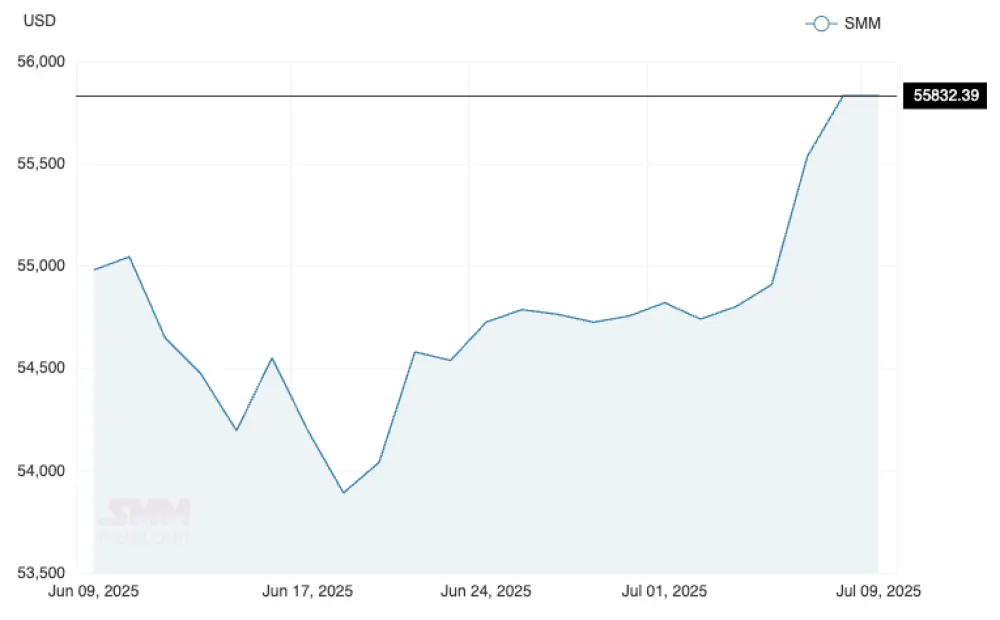
Brazil bất ngờ trở thành tâm điểm đất hiếm toàn cầu khi giá tăng gấp 5 lần và Lynas nhắm tới
-
Trung Quốc siết chặt xuất khẩu khiến giá đất hiếm tăng gấp 5 lần tại các thị trường phương Tây, đẩy các công ty như Lynas (ASX:LYC) tìm kiếm cơ hội khai thác tại Brazil và Malaysia.
-
Brazil sở hữu các mỏ đất sét ion giàu đất hiếm – loại dễ khai thác, ít tốn năng lượng, chi phí thấp hơn mỏ đá cứng như dự án Mt Weld của Lynas (106,6 triệu tấn, 4,12% TREO).
-
Lynas hiện là nhà sản xuất đất hiếm nặng lớn nhất ngoài Trung Quốc, với sản phẩm dysprosium oxide (5/2025) và terbium (6/2025).
-
Đất sét ion tại Brazil chủ yếu tập trung ở Minas Gerais, Bahia, Goias và Amazonas, nơi có điều kiện khí hậu cận nhiệt đới lý tưởng cho quá trình hình thành mỏ.
-
Brazilian Critical Minerals (ASX:BCM) sở hữu dự án Ema với tài nguyên 943 triệu tấn tại 716ppm TREO, bao gồm vùng khởi đầu 341 triệu tấn chứa đất hiếm nam châm như neodymium, praseodymium, dysprosium và terbium.
-
Nghiên cứu khả thi tháng 2/2025 cho thấy dự án Ema có NPV sau thuế 498 triệu USD, IRR 55%, thời gian hoàn vốn chỉ 2 năm, vốn đầu tư ban đầu 55 triệu USD.
-
BCM là dự án duy nhất tại phương Tây áp dụng thành công công nghệ khai thác tại chỗ (ISR) đối với đất sét ion, giúp giảm đáng kể rủi ro và chi phí.
-
Axel REE (ASX:AXL) đang phát triển dự án Caladão tại Minas Gerais, với khoáng hóa REE và gallium, trong đó đạt 2m tại 124g/t gallium và 11m tại 2.718ppm TREO.
-
Perpetual Resources (ASX:PEC) đang lập kế hoạch cho giai đoạn khoan tiếp theo tại dự án Raptor, với kết quả thu hồi tới 94% đất hiếm nam châm và khoáng hóa lên đến 8.029ppm TREO.
-
PEC cũng phát hiện lithium (spodumene) và caesium (pollucite) tại dự án Igrehinha.
-
Verity Resources (ASX:VRL) sắp khởi động chương trình khoan tại dự án Pimenta, với kết quả khảo sát cho thấy tới 25.817ppm TREO, trung bình 25% đất hiếm nam châm trên 147 mẫu.
📌 Brazil nổi lên như ứng viên hàng đầu thay thế Trung Quốc trong chuỗi cung ứng đất hiếm toàn cầu. Dự án Ema đạt 943 triệu tấn tài nguyên, với chi phí đầu tư thấp và công nghệ khai thác tại chỗ tiên tiến. Các công ty ASX khác cũng tăng tốc tại khu vực này khi giá đất hiếm tăng gấp 5 lần do hạn chế xuất khẩu từ Trung Quốc.
https://stockhead.com.au/resources/why-brazils-rare-earth-deposits-could-catch-major-attention/
Why Brazil’s rare earth deposits could catch major attention
Mining 10 Jul 2025 Jessica Cummins
As Chinese export curbs send rare earth prices through the roof, Lynas (ASX:LYC) could be plotting a Brazilian breakout that would loosen Beijing’s stranglehold on the materials powering the world’s transition to EVs.
While a mega merger with America’s MP Materials isn’t currently on the cards, the company – now the largest producer of separated heavy rare earths outside China after producing its first batch of dysprosium oxide in May and terbium in June – is reportedly eyeing ionic clay deposits in Malaysia, and to a lesser extent, Brazil, where vast granite belts have been slowly cooking up rare earth riches for eons.
Through millennia of weathering, rare earth elements (REEs) leach from the parent rock and accumulate in clay-rich deposits containing kaolinite and halloysite – creating concentrated, potentially economic rare earth resources.
These resources are typically found in subtropical climates, like Malaysia, parts of Brazil, China and Myanmar.
The beauty of these deposits is their promise for simpler, cost-effective extraction.
Hard rock deposits, such as Lynas’ 106.6Mt Mt Weld project (averaging 4.12% TREO), typically offer higher rare earth grades but extraction can be energy-intensive, costly and requires complex processing methods like flotation and hydrometallurgy.
Ionic clay deposits, on the other hand, are found near surface, making it easier and cheaper to explore, drill and mine.
REEs from these types of resources can also be extracted through environmentally friendly processes using solutions with low pH.
REE prices up five-fold
In an interview with Stockhead, Brazilian Critical Minerals (ASX:BCM) managing director Andrew Reid said this helps explain why rare earths giant Lynas may be looking to invest in ionic clay, despite building its success on hard rock assets like Mt Weld.
“The cost of extraction is so much cheaper than what they’re doing in Australia right now,” he said.
“They’ve already spent an enormous amount of money setting up their project, but it also costs a lot to keep going and they’re highly leveraged to the chemical price, particularly for sulphur, because they use a lot of sulphuric acid,” he said.
“I think they’ve been prudent in looking at other opportunities to source rare earths to their clients that can be done quicker, faster and safer, until now.”
Chinese export controls have triggered magnet shortages, leaving some automakers struggling to source rare earth magnets, essential for motors, windshield wipers, speakers, and air conditioners used in both EVs and conventional cars.
In retaliation for tariffs imposed by the Trump Administration, China in April imposed export limits on seven medium and heavy rare earth elements.
Market analysts from Shanghai Metals Market, one of only a handful of price reporting agencies for rare earths, suggest that improving demand may also fuel price increases. In America, buyers have anecdotally been driving prices through the roof to get their hands on suddenly limited supply.
“I was just in the States and Canada over the last few weeks and the rare earth price there has gone ballistic,” Reid said.
“I was hearing of prices up to five times higher than the Chinese price being offered for rare earths right now in the west, but the big question is, how long will that last?”
“Will the Chinese reduce their export controls to rebalance the market? Because they very much want to keep control of the rare earth sector, that’s their primary aim,” Reid said.
“They don’t want the price to climb and remain high for very long because they don’t want to incentivise (competitors).”
One of the world’s largest ISR projects
In Brazil, ionic clay deposits are primarily found in the state of Minas Gerais, particularly within the Pocos de Caldas alkaline complex, while other areas include Bahia, Goias and Amazonas.
Brazilian Critical Minerals owns the Ema project within Brazil’s northwestern Apuí region, host to one of the world’s largest ionic clay rare earth deposits with a resource of 943Mt at 716ppm total rare earth oxides.
It includes a starter zone of 341Mt, including high-value magnet rare earths used to make permanent magnets for advanced technology like EVs, wind turbines and particle accelerators.
A scoping study completed in February 2025 outlined a post-tax net present value of US$498 million for the Ema project, with an internal rate of return of 55% and a payback period of about two years on capex of just US$55m.
The company has now successfully trialled in-situ recovery, which Reid said is the same methodology used in Southeast Asia to extract ionic clays.
It’s been successful in lowering the in-situ pH to levels that demonstrate clear migration of magnesium sulphate throughout the clay layers, indicating that REEs are now at a stage where they can be effectively ionically leached into solution.
“We are the only project in the Western world that has been successful at extracting clays by ISR, which significantly derisks the project” he said.
“You need a very niche set of criteria in order to be able to execute ISR and we just happen to have those at Ema.
“Hopefully there are more that are discovered but at the moment we’re the only ones where you can apply this very cheap technology to the extraction of rare earths – that’s a very big kudos to the sector and certainly a big kudos for Brazil.”
Other ASX rare earth players in Brazil
Axel REE (ASX:AXL) operates the Caladão project in the prolific mining province of Minas Gerais, Brazil where mineralisation is found within a thick regolith profile, rich in clay minerals such as REEs and gallium.
The company recently hit up to 2m at 124g/t gallium from surface in its latest round of drilling while auger drilling revealed the presence of rare earth mineralisation, peaking at 11m at 2718 parts per million total rare earth oxide from 6m, with three more intersections grading above 1200ppm TREO.
Existing exploration at Caladão covers only about 20% of the total 430km2 project area, offering plenty of potential for further discoveries.
These latest drilling results will support a maiden resource or gallium and rare earth elements at Area B, with calculations for Area A’s mineral resource already underway via SRK Consulting, a mineral exploration services firm.
Perpetual Resources (ASX:PEC) is in the middle of planning the next exploration phase at its Raptor project in Brazil, home to ionic adsorption clay (IAC) style REE mineralisation.
This type of asset boasts several advantages including being enriched with a higher proportion of the more valuable REEs like praseodymium, neodymium, terbium and dysprosium.
So far, metallurgical testing has demonstrated high recoveries of up to 94% for key magnet rare earth elements with initial drilling intersecting high-grade mineralisation, returning a standout 1m interval grading up to 8029ppm TREO.
The company is hoping the next campaign will support its pathway towards delivering a maiden resource, which is possible for as early as late calendar year 2025.
Other objectives of the program include extending known mineralisation and exploring new targets. PEC is also exploring for lithium, tin and caesium in minerals rich Brazil, confirming on Wednesday that drilling at its Igrehinha project had hit both lithium host mineral spodumene and caesium host mineral pollucite.
And Verity Resources (ASX:VRL) is planning a maiden auger drill program at its Pimenta project in Minas Gerais, Brazil, focusing on a 20km high-grade rare earths-gallium-titanium zone.
Drilling will follow recent reconnaissance work which returned up to 25,817ppm total rare earth oxide (TREO), with an average of 25% high value magnet rare earths (MREO) over 147 samples.
VRL, which also owns gold resources in WA’s Laverton district, believes the results to date confirm a mineralisation style potentially similar to American Rare Earths’ (ASX:ARR) Halleck Creek allanite REE deposit with a 2.63Bt at 3292ppm TREO resource, one of the largest in the US.
Importantly, the REE geochemical signature remains consistent between rock and regolith samples, supporting a model of vertical enrichment via residual weathering.
Thảo luận
Follow Us
Tin phổ biến



